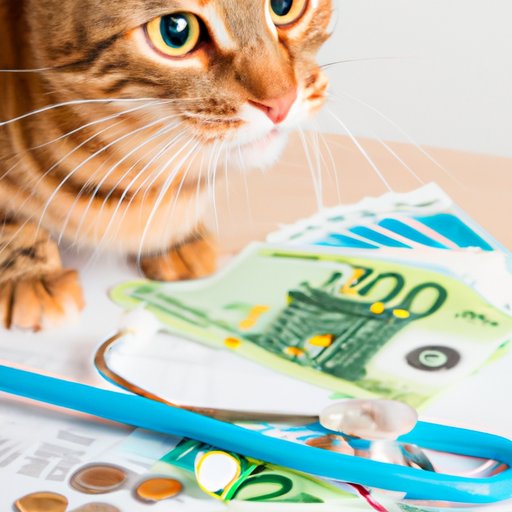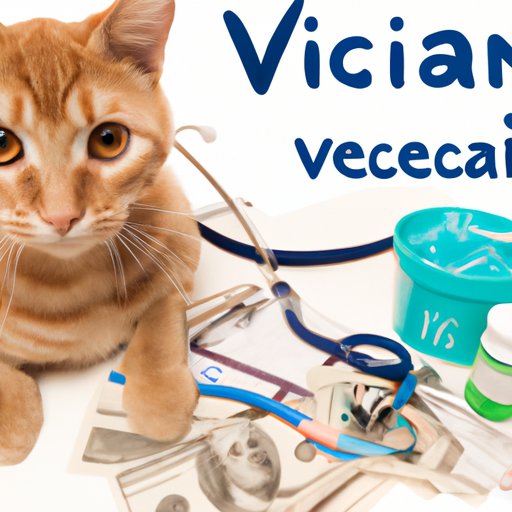Introduction
Cats are beloved companions and members of the family. As such, it is essential that they receive regular veterinary care to ensure optimal health and wellbeing. But how much does it cost to take a cat to the vet? This article will explore the various costs associated with veterinary care for cats, from examinations to diagnostic tests and treatments.

Exploring Costs for Veterinary Care for Cats
Veterinary care for cats can include a variety of services and procedures. The most common services include physical examinations, vaccinations, prescription medications, and surgery. Each of these services has its own associated cost, which can vary depending on the type of procedure, the veterinarian’s experience and location, and other factors.
The average cost of a physical examination ranges from $30 to $60, depending on the complexity of the exam and the veterinarian’s experience. Vaccinations typically range from $10 to $20 each, while prescription medications can cost anywhere from $10 to $100, depending on the medication and dosage.
Surgery and hospitalization can be significantly more expensive than other services, with costs ranging from $500 to $2,000, depending on the type of procedure and the severity of the condition. Some surgeries may require overnight stays at the hospital, which can add to the total cost of the procedure.
What to Expect When You Take Your Cat to the Vet
When you bring your cat to the vet, the first thing that will happen is a physical examination in the examining room. During this examination, the veterinarian will check your cat’s eyes, ears, nose, and mouth, as well as listen to their heart and lungs. Depending on the results of the exam, the veterinarian may recommend additional tests or treatments.
Diagnostic tests can include blood work, X-rays, ultrasounds, and urinalysis. These tests can help the veterinarian determine the cause of any medical issues your cat may be experiencing. Once the cause is determined, the veterinarian can then provide appropriate treatment options, such as medications, surgery, or other therapies.

How to Budget for Veterinary Care for Your Cat
It is important to plan ahead when it comes to veterinary care for your cat. Set aside funds for emergency situations, such as sudden illnesses or accidents. Research different payment options, such as pet insurance plans, to help cover the cost of routine visits and treatments.
If your cat needs an expensive procedure, such as surgery, talk to your veterinarian about payment plans or other financing options. Many veterinarians offer discounts for certain services or procedures, so be sure to ask about any available discounts.

A Guide to Veterinary Costs for Cat Owners
When preparing for a visit to the vet, it is important to understand the billing process. Make sure you know what is included in the fee, such as the examination, diagnostic tests, medications, and treatments. Be sure to ask your veterinarian about any additional fees that may not be included in the base price.
Also, make sure to ask about any follow-up appointments that may be necessary after the initial visit. These follow-up appointments may involve additional fees, so it is important to factor them into your budget.
The Average Cost of Taking a Cat to the Vet
The average cost of taking a cat to the vet can vary greatly depending on the services needed. Routine visits and vaccinations typically cost between $30 and $60. Prescription medications can range from $10 to $100, while surgery and hospitalization can cost anywhere from $500 to $2,000.
It is also important to factor in monthly, annual, and one-time costs. Monthly costs may include flea and tick prevention, heartworm prevention, and other preventative care. Annual costs may include vaccinations and yearly exams. One-time costs may include spay/neuter surgery, dental cleanings, and other procedures.

A Breakdown of Veterinary Services and Fees for Cats
Vaccinations are an important part of preventive care for cats. Vaccines help protect against a variety of diseases and are typically given once a year. The cost of vaccinations can range from $10 to $20 each.
Prescription medications may be necessary to treat a variety of conditions, from infections to allergies. The cost of medications can vary widely, depending on the type of medication and dosage. The cost typically ranges from $10 to $100.
Surgery and hospitalization can be necessary for a variety of conditions, such as birth defects, injuries, or illnesses. Surgery and hospitalization can be costly, with prices ranging from $500 to $2,000, depending on the type of procedure and the severity of the condition.
Preparing Financially for Veterinary Visits for Your Cat
It is important to plan ahead and prepare financially for veterinary visits. Setting aside funds for emergencies can help ease the financial burden if your cat needs medical attention. Researching different payment options can help you find ways to save on veterinary care.
You can also look for discounts or special offers from local veterinarians. Many veterinarians offer discounts for certain services or procedures, so be sure to ask about any available discounts.
Conclusion
Taking your cat to the vet is an important part of providing proper care and ensuring their long-term health and wellbeing. Veterinary costs can vary, depending on the services and procedures needed. Understanding the different types of services and fees can help you budget for veterinary care and prepare financially for unexpected expenses.
By researching different payment options and looking for discounts, you can save money on veterinary care for your cat. Planning ahead can help you be prepared financially for any medical emergencies that may arise.
(Note: Is this article not meeting your expectations? Do you have knowledge or insights to share? Unlock new opportunities and expand your reach by joining our authors team. Click Registration to join us and share your expertise with our readers.)
